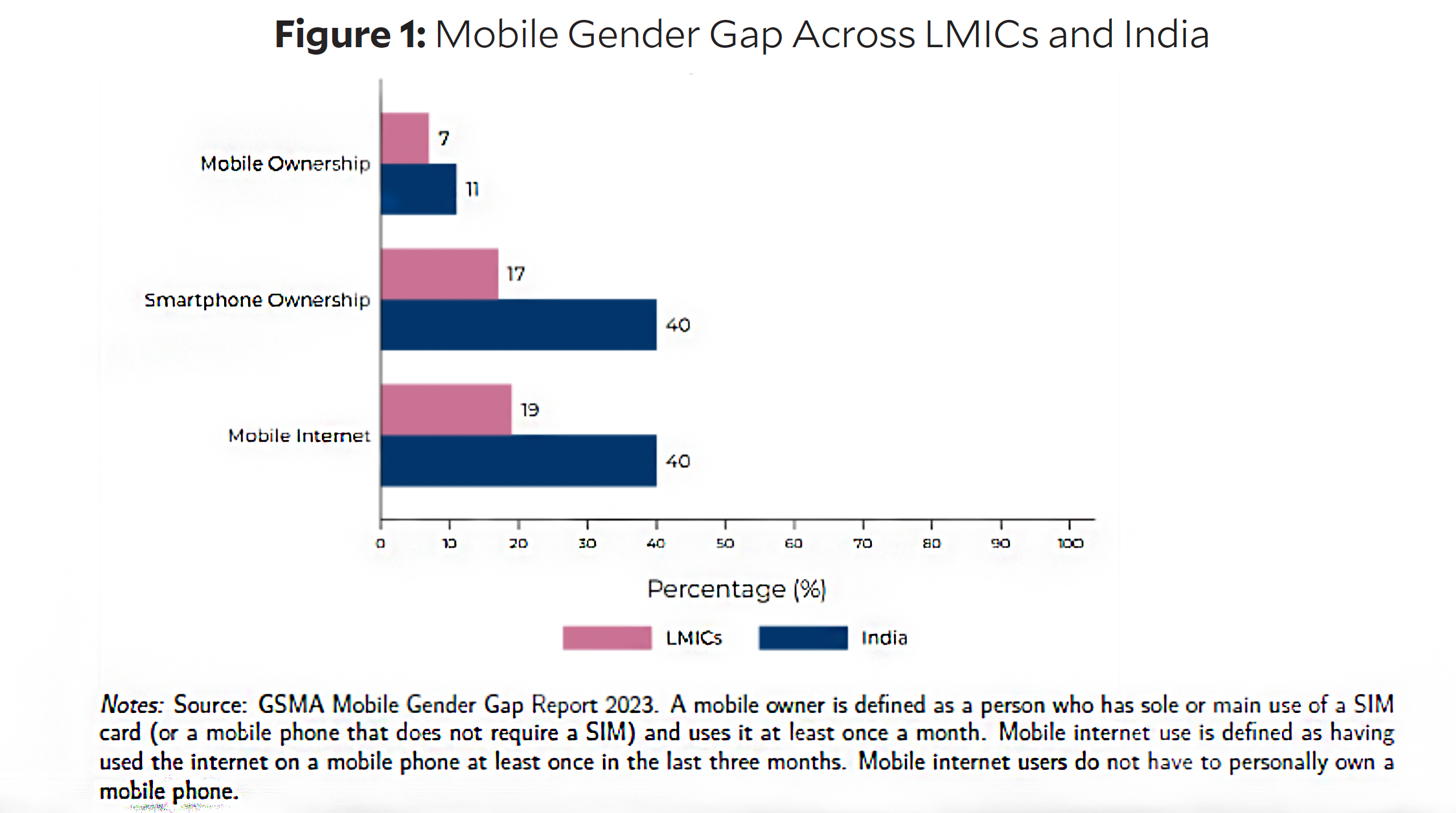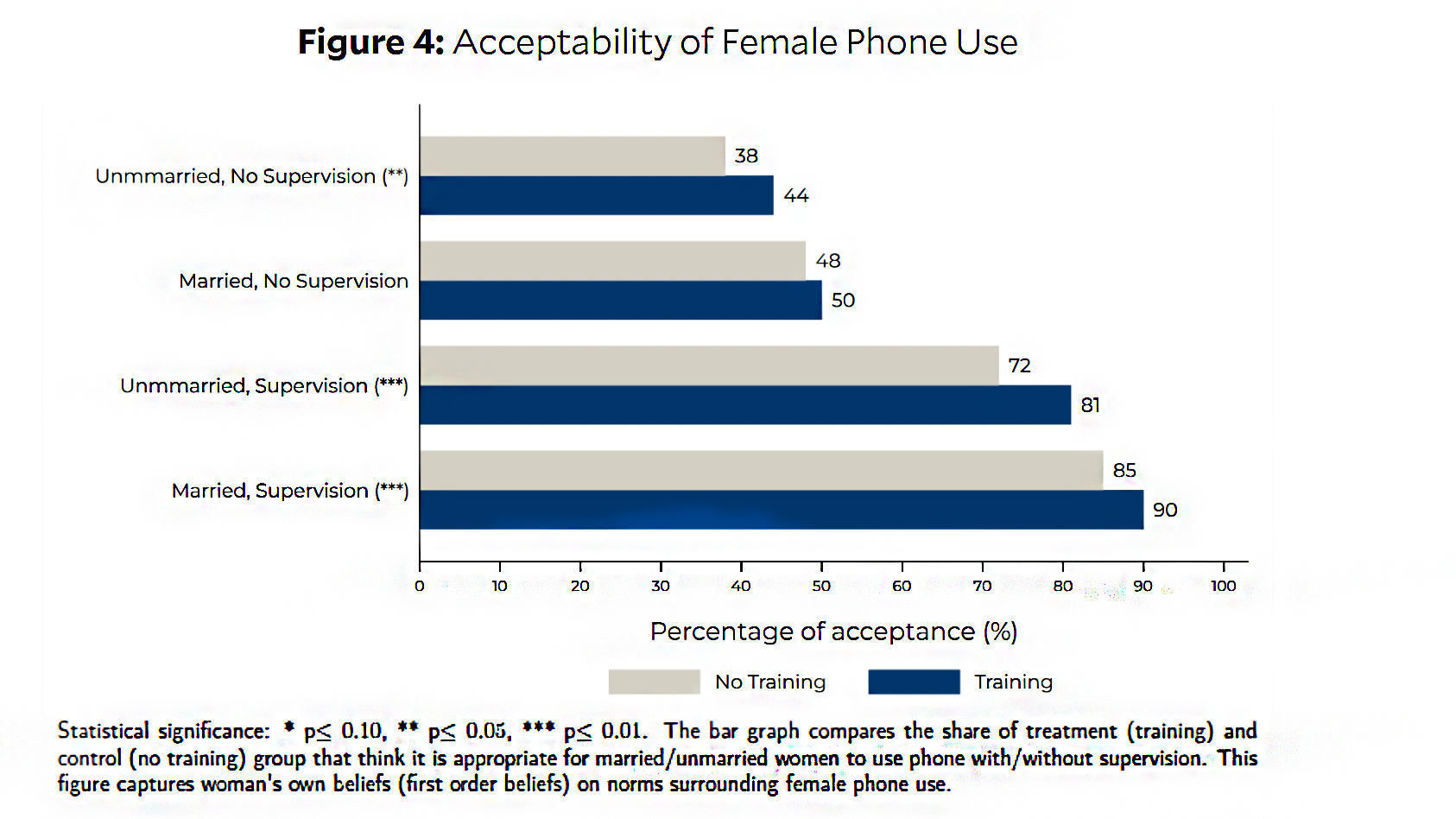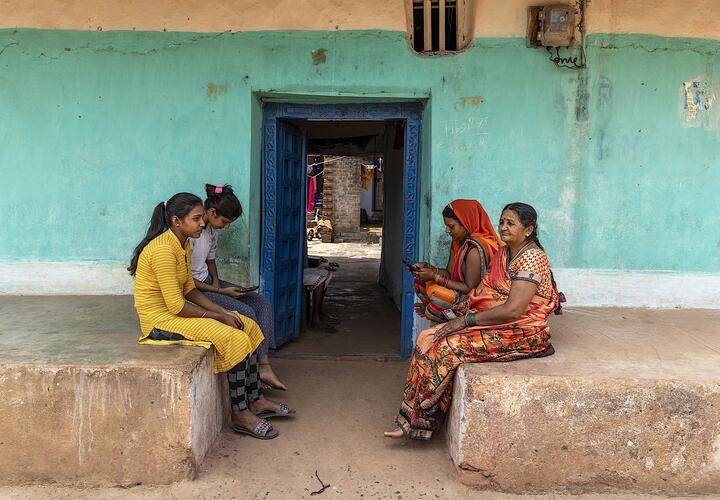Research in India by the Inclusion Economics network shows that offering women brief, small-group, digital literacy classes amplifies their mobile phone use and has large returns two years later.
Women exposed to these classes report lower depression and anxiety. A possible channel is increased interaction with relatives and friends.
They also embrace more liberal beliefs about appropriate mobile phone and internet use for women.
BACKGROUND
In LMICs, where people access the internet primarily with mobile phones, mobile phone use advances financial inclusion, education, employment, and physical and mental health. Yet as Figure 1 shows, gaps in mobile phone use and ownership persist. In gender-unequal countries like India, where women are 40% less likely than men to own a mobile phone or use mobile internet, prevailing gender norms that view mobile technologies as a threat to women’s traditional roles contribute to the mobile gender gap.
Recognizing the many benefits of mobile phone and internet access, governments and NGOs in India and other LMICs have established programs to distribute free mobile phones or provide more affordable phone financing.1 However, even programs that focus on distributing mobile phones to women overlook the underlying normative gender constraints and limited digital skills that may impede women’s use of mobile technology.
To more effectively address the mobile gender gap in India, the Inclusion Economics network is designing and implementing interventions that build on existing Indian government mobile phone distribution programs while taking into account the gender-specific social constraints and knowledge gaps that may restrict women’s use of mobile technology. In 2018, the Government of Chhattisgarh distributed free smartphones to over 2 million rural women, along with 1GB of free data for the first 6 months, and ensured that all program villages had LTE coverage. Seeking to understand how to amplify the benefits of such programs, the Inclusion Economics network conducted a randomized controlled trial (RCT) with 3,816 Chhattisgarhi households already benefiting from the smartphone distribution program. The RCT examined the effect on women’s mobile phone usage of offering brief, interactive digital technology classes to small groups of women, who together learned skills compatible with traditional gender norms. Women in the study also received take-home handouts with simple visual instructions for common mobile phone tasks suited to women’s daily lives.
 GSMA Mobile Gender Gap Report 2023
GSMA Mobile Gender Gap Report 2023
Findings
DIGITAL LITERACY TRAINING INCREASED WOMEN’S USE OF SMARTPHONES BY ALMOST 5 PERCENTAGE POINTS, EVEN TWO YEARS AFTER THE CLASS.
In the 45-minute digital literacy classes conducted by the Inclusion Economics network, small groups of women who had received free smartphones from the Government of Chhattisgarh learned to complete specific mobile phone tasks compatible with gender norms, such as taking a photo, making and receiving calls, and performing a Google voice search. More than two years after the classes, the percentage of women who used a smartphone in the last month increased from 77.5% to 82.3%. These women engaged more frequently and deeply with their mobile phones, using them more often and for a wider range of tasks than those who received a smartphone but no training.

THE TRAINING IMPROVED MENTAL HEALTH OUTCOMES.
Indian women are more likely than Indian men to suffer from depression and anxiety disorders, a disparity that may be linked to women’s high levels of social isolation.2 Although recent research has shown negative mental health impacts of mobile phones in wealthier countries, nascent research links mobile phones to positive mental health outcomes in LMICs.3 Consistent with this literature, participants in the digital skills classes disclosed fewer feelings of depression and anxiety in their responses to an ultra-brief mental health screening survey than did non-participants. Using the Four Item Patient Health Questionnaire, researchers found that training decreased the percentage of women at risk for depression from 38% to 31.5% and the percentage of women experiencing moderate or worse psychological distress from 35% to 30%.

DIGITAL LITERACY TRAINING ALSO LIBERALIZED BELIEFS ABOUT APPROPRIATE INTERNET USE FOR WOMEN.
Women who participated in the digital skills class were more likely to approve of women’s use of mobile phones despite prevailing social norms that see this technology as a potential threat to women’s traditional role in the home. While the training did not significantly impact social acceptance of mobile phone use by married women without supervision, it did significantly increase social acceptance of unsupervised mobile phone use from 38% to 44% for unmarried women. Likewise, social acceptance of mobile use by women under supervision increased from 85% to 90% for married women and from 73% to 82% for unmarried women.

Policy Insights
Given the many social and economic benefits of mobile phones for people in LMICs, policymakers are already establishing programs to increase mobile access among disadvantaged communities, either by distributing free mobile phones or offering accessible financing options. While a number of these programs have targeted women, who in many LMICs have lower rates of mobile ownership and use, they have not addressed some of the key underlying socioeconomic factors that may contribute to this mobile gender gap.
Recent research by the Inclusion Economics network shows that packaging these programs with brief, small-group digital literacy classes can amplify the positive effects of mobile phones at low additional cost. Teaching women how and why to use mobile phones not only accelerates their use of this technology but also improves mental health outcomes and liberalizes their views of socially acceptable mobile phone use.
1 For example, in 2022, the Pakistani government launched a program allowing anyone to buy a smartphone in interest-free installments, making the technology more accessible to low-income people. In India the same year, the Government of Uttar Pradesh distributed more than 1 million free smartphones and nearly 1 million free mobile phones to youth and the Government of Rajasthan announced a program to distribute free smartphones with three years of free internet to more than 13 million women. See “Govt launches Interest-Free Installment Scheme to Buy Mobile Phones in Pakistan,” incpak.com, Nov. 23, 2022; See “Over 2.45L tablets, smartphones distributed in UP,” The Pioneer, April 2, 2022; “Rajasthan: Smartphones with free internet for 1.35 crore women from October,” Times of India, Sept. 23, 2022.
2 See “The burden of mental disorders across the states of India,” The Lancet 7.2 (February 2020), pp. 148-161; Andrew et al., (2020), “Mothers’ Social Networks and Socioeconomic Gradients of Isolation”; Amy Novotney, “The Risks of Social Isolation,” Monitor on Psychology 50.5 (May 2019), p. 32.
3 A recent study of a nationally representative set of low-income adults in Ghana during the COVID-19 pandemic found that those who received mobile calling credits experienced a 9.8 percentage point decrease in mental distress. See Belinda Archibong and Francis Annan, “Using information and communication technology to improve mental health in Africa,” Brookings Institution blog, May 16, 2023.
 Ishan Tankha
Ishan Tankha
